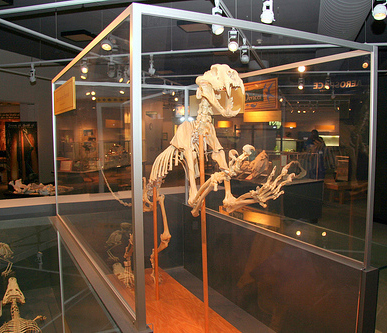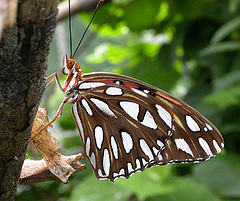North Carolina Museum of Life and Science
by Martha Bethea, 2006
 See also: Museums
See also: Museums
The North Carolina Museum of Life and Science in Durham was founded in 1946 as the Children's Nature Museum. The original facility was a small trailside nature center adjacent to Northgate Park (then the Northgate Bird Sanctuary) that offered natural history exhibits and classes. In 1949 the museum incorporated and moved to an old white house on Georgia Avenue. In 1961 its Board of Directors secured a long-term lease from the city of Durham for a site on Murray Avenue and started construction of buildings on the south side of the campus. At the time, the museum was distinguished by a "Pre-History Trail," which opened in 1967, followed by an outstanding aerospace exhibit, which opened in 1975. The Ellerbee Creek Special, a replica of the famous C. P. Huntington train of the Southern Pacific running along a mile-long course, opened in 1977.
The development of the museum paralleled the growth and change of the region it served. Though the north central region of North Carolina retains a rural tradition, it became home to the Research Triangle Park, encompassing many hightechnology, science-based companies doing research and manufacturing in such diverse fields as biotechnology, pharmaceuticals, computer electronics, medicine, and communications. The museum kept pace with this evolution while remaining rooted in a community-service tradition. Its unique dual focus on the natural and physical sciences came to reflect both the traditional and emerging needs of the regional community.
The late 1980s marked the beginning of a second major period of growth in the museum's history. Phase I included the construction of an indoor Nature Center featuring live North Carolina animals. Phase II, completed in 1991, included a new auditorium, temporary exhibit gallery, expanded lobby and gift shop, a new tree house discovery room, and 6,000 square feet of exhibition space. In 1993 Phase III included the completion of a  50,000-square-foot building for new exhibits and the physical science discovery room, Scientifica, increasing the range of programs in the natural and physical sciences. During this period recognition of the museum's commitment to hands-on exhibits came in the form of full membership in the prestigious Association of Science-Technology Centers; only 34 other museums worldwide have been accorded this status.
50,000-square-foot building for new exhibits and the physical science discovery room, Scientifica, increasing the range of programs in the natural and physical sciences. During this period recognition of the museum's commitment to hands-on exhibits came in the form of full membership in the prestigious Association of Science-Technology Centers; only 34 other museums worldwide have been accorded this status.
The third period of growth featured BioQuest as a plan to utilize the museum's full 70-acre campus by expanding its north side with outdoor environmental and animal interactive exhibits, including a permanent Magic Wings Butterfly House and Insectarium, an updated dinosaur trail and dig, and exhibits on flight and large terrestrial animal communication. With the completion of BioQuest, the museum made the "great outdoors" a resource of learning and enjoyment and became a model for museums, zoos, and botanical gardens internationally.
One of the most popular year-round visitor attractions in the , the North Carolina Museum of Life and Science by the beginning of the twenty-first century attracted 300,000 persons annually, including 100,000 students from North Carolina, Virginia, West Virginia, and Maryland. The main facility is 53,000 square feet, including 25,300 square feet of exhibit space and 3,600 square feet of program space. An additional 15,000 square feet of program space is available in other buildings on the museum campus.
Additional Resources:
North Carolina Museum of Life and Science: http://www.ncmls.org/
Image Credit:
Tiger Exhibit at the North Carolina Museum of Life and Science, Durham, NC. Image courtesy of Flickr user Braz Brandt. Available from https://www.flickr.com/photos/braz/57306071/ (accessed August 24, 2012).
Apollo Space Capsule at the NC Museum of Life and Science. Image courtesy of Flickr user ke4roh. Available from https://www.flickr.com/photos/73034657@N00/6159289670/in/set-72157627575508157/ (accessed August 24, 2012).
Butterfly in the Magic Wings Butterfly House, NC Museum of Life and Science. Image courtesy of Flickr user Patrick Coin. Available from https://www.flickr.com/photos/pcoin/99549966/ (accessed August 24, 2012).
1 January 2006 | Bethea, Martha